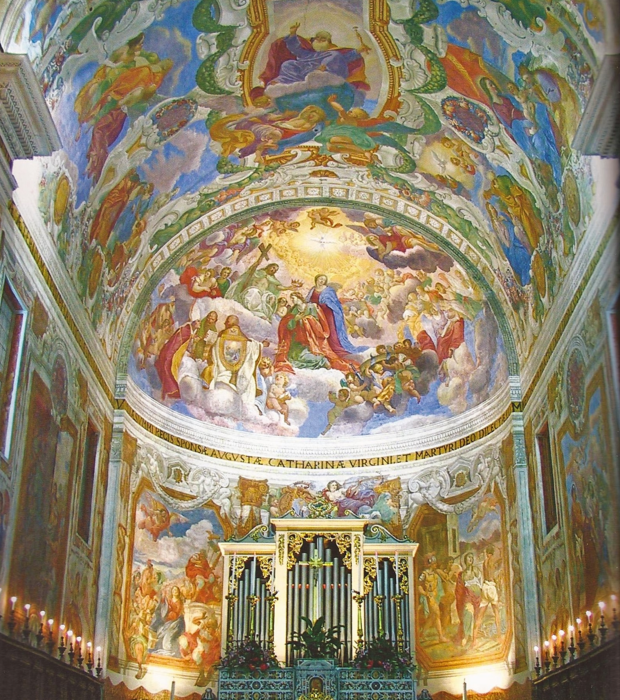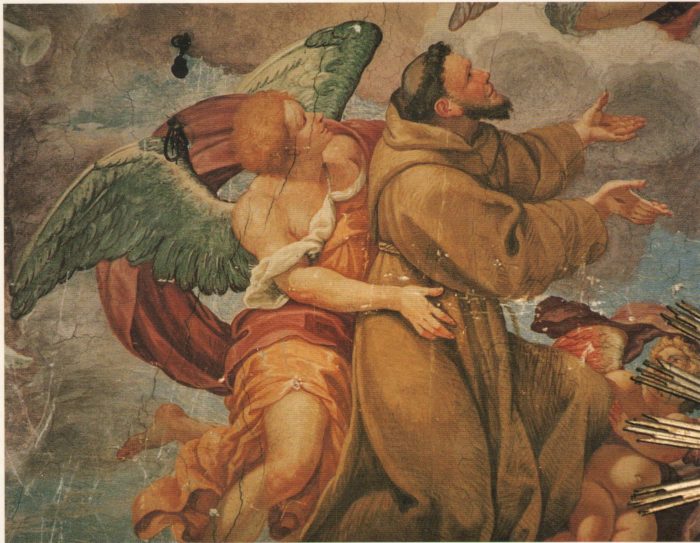Giovanni Lo Coco (1667–1721)
Click on the images to find out more
Giovanni Lo Coco was born in 1667 in Acireale to Paolo Lo Coco and Agata Grasso. A self-portrait frescoed in a lunette in the cloister of the convent of San Biagio in Acireale shows the painter fully dressed, with a voluminous wig, reddened cheeks, and holding a palette in his left hand. His clothing might suggest an aristocratic background, a theory supported by the fact that at a young age he was sent to Rome to study under the direction of Pietro Aquila, a highly esteemed engraver from Palermo. Lo Coco was influenced by the classicist style that dominated Roman painting in the second half of the seventeenth century and learnt to imitate the manner of painters who were a part of this tradition, in particular that of Carlo Maratta.
A payment dated 1711 for the decoration of a wooden door in the chapel dedicated to Santa Venera in the basilica of the Santissima Annunziata in Acireale attests that at the end of the first decade of the eighteenth century Lo Coco had returned to Sicily. The return to his homeland coincided with the implementation of a vast restructuring program of the buildings of worship in Catania organised by the Spanish government following the disastrous earthquake that affected eastern Sicily in 1693. Within this context, Lo Coco received a commission from Diego Pappalardo, a priest and member of the Order of Malta, to decorate the Basilica of Santa Caterina in Pedara with frescoes illustrating the stories of St. John the Baptist and St. Catherine of Alexandria. Between 1713 and 1715, Giovanni moved to Acireale where he completed the fresco decoration of the church and cloisters of the convent of San Biagio, which was also rebuilt following the earthquake. There he illustrated 22 large lunettes characterised by a magniloquent and monumental style with episodes of the life of St. Francis of Assisi. Beyond just the figures, the artist’s skills in landscape painting are highlighted, a legacy of his Roman past.
Aside from working as a fresco decorator it is possible that Giovanni also tried his hand at making altarpieces. To this end, in their collection, the Pinacoteca Zelantea in Acireale holds an Adoration of the Shepherds, a copy of a painting by Guido Reni, which on the right margin reads “HOC OPUS FECIT JOANNES COCO”.
Bibliography
Buda, Virginia and Lamuzza, Stefania, Sulle vie dei cavalieri di Malta: il Valdemone Catanese. Messina, 2008, 274-275.
Sarullo, Luigi. Dizionario degli artisti siciliani. Pittura. Palermo, 1993, 255-256.
Donato, Matteo. La Pinacoteca Zelantea di Acireale. Acireale, 1992, 7.
Trovato, Katia and Aurelio Grasso. Storia e arte nel convento di S.Biagio. S. Biagio. Acireale, 1996.
Candido Carpinato, Notizie sui pittori acesi. Acireale, 1758.


